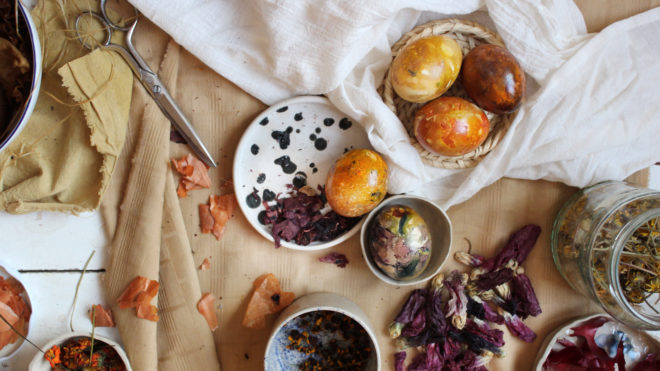Your basket is currently empty!

Dyeing easter eggs with plants
Dyeing Easter eggs with plants can be a simple and exciting project with kids - or you something you do just by yourself (perhaps for your inner child) as I did.
We're approaching the second Easter in this pandemic. And while I haven't been out searching for Easter eggs in a long time, as a child it was my very favourite family celebration.
Returning to this childhood ritual (on my own terms, with plants!) feels like being around family when gathering all of us isn't possible right now.
There are many different ways to plant dye your eggs, and there are really only two things you need to be aware of: don't break your eggshells and make sure to use food-safe plants.
I decided to contact dye or eco print my easter eggs in tiny Bundle-Dyepackages. I wrapped the eggs with dye plants into small pieces of fabric. If you want to do this project with kids, pre-boil the eggs to prevent accidents – I just handled to eggs very gently.
To wrap the bundle I chose fabric scraps I wanted to over dye anyway. You could also use an elastic material – like jersey, or stockings. In that case the plant matter will be pressed gently onto the egg shell for clearer prints.



Once you gathered your egg bundles – off they go onto your stovetop. To make them safe to store for a little while, make sure to boil until the eggs are hard. In my case about 10 minutes, you may have to adjust depending on the size of your eggs. Eggs with cracked shell need to be stored in the fridge and should be consumed soon.
Allow the eggs to cool for a bit before you unwrap. I used a brush and also a damp sponge to carefully remove any plant matter sticking to the shells. Your dyed eggs will shine and look especially nice if you rub them with a small drop of oil!


If you'd like clear colour nuances and prints, use white eggs for this. I had two very light and three dark eggs. If you use different plants in your bundles and don't want the colours to mix, you should steam the eggs instead of putting them together in a pot of water like me.
Plants to dye eggs
I rummaged through the pantry for plants to use and opted for yellow and red onion skins, hibiscus flower tea, and a few (food safe) dried flowers from the garden - orange cosmos, tickseed, dyer's chamomile, hollyhock.
The chamomile flowers are quite bulky and I would not really recommend them, but everything else went well. My favorites: the humble onion skin once more, and hibiscus flowers.
Other plants that would be fun: strips of red cabbage, beetroot, purple carrot. Right now I had the idea that black lentils would probably also make a cool pattern! The great thing about dyeing easter eggs is that the dyes can be fugitive. Most everything mentioned here in shades of purple and blue belongs to these more ephemeral colours (beetroot, red cabbage, purple flowers ...). In many cases I wouldn't use these plants to dye fabrics and clothing. But the easter eggs don't last for too long, anyway.

As always, just because something's natural doesn't mean it can't be poisonous. If you already have different dye plants at home - not all of them are food safe, please do some research before using them for edibles! Madder, for example, was previously used medicinally and as a food coloring, but is not and bushier.
For plain dyed eggs, you can also make dye baths instead: Cover the plants with enough water and simmer until the extraction looks strong. Ingredients from the kitchen could for example be yellow or red onion skins, turmeric, red cabbage, beetroot, hibiscus tea ...
Hope you enjoy, if you decide to give this a try!

Leave a Reply